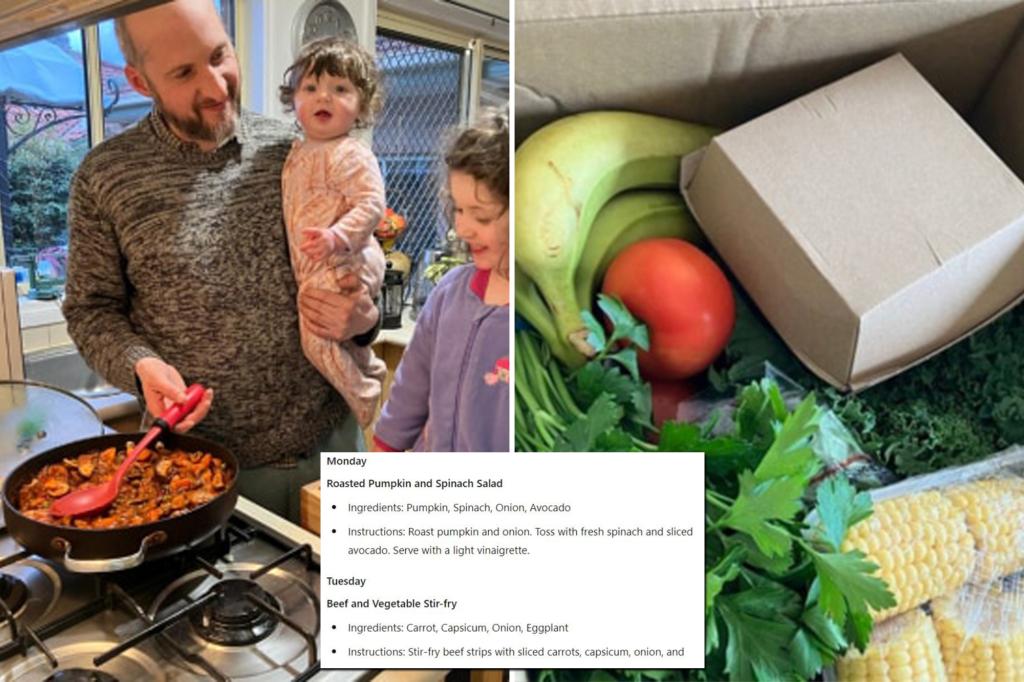Summarize this content to 2000 words in 6 paragraphs
Before he became a dad three years ago, Jonathan had his meal planning skills down pat when it came to cooking for himself and wife, Farrah.
“I was actually quite meticulous with it and I had a lot of time to do it effectively, but once we had kids, we became time poor and it became chaotic,” the Melbourne father of two children, aged three and seven months, tells Kidspot.
“Meal planning was completely thrown off and having time to prepare a meal was thrown off too.”
Earlier this year, Jonathan and Farrah, who both work full time, decided to streamline their weekly chore list by ordering a home-delivered fruit and vegetable box from a company that sources produce that supermarkets would otherwise reject because of their imperfections.
So far, they have chosen a Farmers Pick $50 [$33 USD] couples box, which gives them 10kg [22 lbs] of fruit and vegetables, but soon plan to choose a $69 [$45 USD] family box which has 15kg [33 lbs] of produce. All produce is chosen by the supplier, not the customer.
It was this change that led the 39-year-old dad to find a completely new way to feed his family – using artificial intelligence AI, specifically, ChatGPT.
“We started getting things in the box that I wasn’t really familiar with cooking, such as kale and bok choy, and I’d been using GPT-4.0 for other things, so I thought I would try using it to suggest meals for whatever ingredients we had that week,” he says.
Asking AI to help with dinner was a game-changer
While it may seem like a frighteningly technical task to do each week, Jonathan – who has been using AI for everything from helping with his work as a high school science teacher to coming up with new craft activities for his toddler – says the technology is very easy to use.
“You just type in the ingredients and quantity you want to use, such as what’s in the veg box, and I also mention I want to use pantry staples and protein, and that’s all the information it needs to come up with pretty good suggestions for a week’s worth of dinners,” he says.
“You can be as specific or as vague as you like, but I found with trial and error, the more information you put in, the better the result.”
ChatGPT even provides suggestions for meals that are egg and nut free to cater for Jonathan’s eldest child’s allergies.
“You just add that requirement in, and we also add in things we don’t like to eat, so it really caters to your needs and tastes,” he explains.
“When one meal came up with prawns in it, I just put in, ‘I don’t like the Monday meal, please change it to something without prawns’, it did that really well. It always gives me ideas I wouldn’t have thought of before.”
The best part, he says, is the whole process to create a full week’s dinner meal plan takes just a few minutes, and saves the family money since there is no wastage.
“I used to input the vegetables manually but there’s a new feature now where you can take a photo of them and it will create meals from that, which will save even more time,” he raves.
“And those dinners will often be what Farrah and I take to work the next day as leftovers, so it’s really worthwhile.”
All the chat history is saved (or can be deleted), so Jonathan can revert back to previous recipes if his family decide to eat something other than what ChatGPT has suggested for that day.
No turning back
Safe to say, Jonathan won’t be reverting back to the traditional way of meal planning anytime soon.
“It’s been amazing for us, so we’ll keep using it for sure,” he says.
“It’s removed the mental load of coming home from work and wondering what to make that night and they never feel like they’re recipes that are just thrown together ingredients, they feel like I’m cooking from a cookbook. Everything about this works better – we aren’t buying things we don’t need and the produce lasts longer than if we buy it at the supermarket. It’s been an amazing time saver too.”















